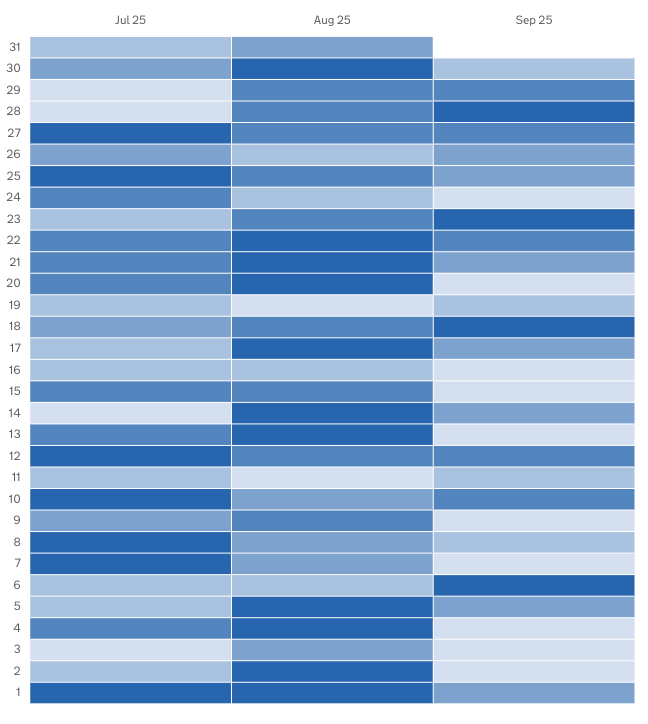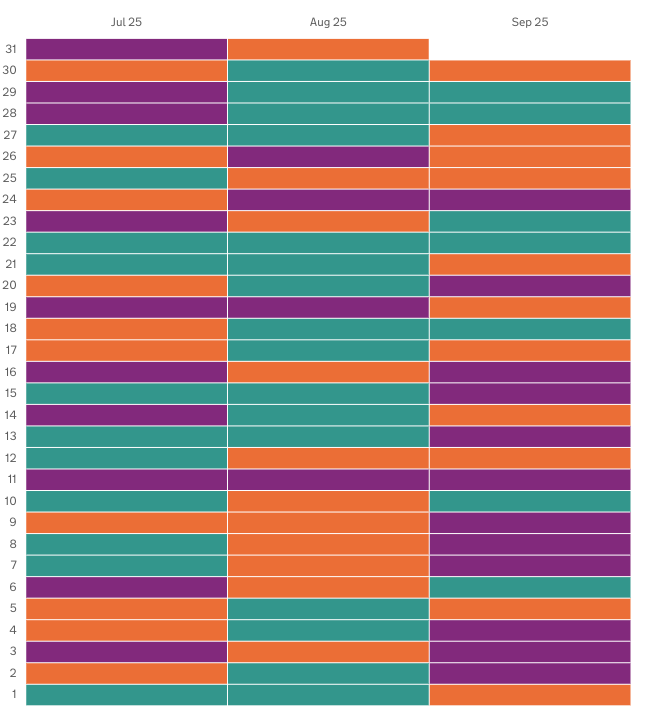Visualisation definition Matrix timeseries chart


The matrix-timeseries chart visualisation type represents data as a matrix/heatmap chart visualisation.
When to use
Use this visualisation type when you need to display historic data as a heatmap, or as a Red, Amber, Green traffic-light conventions.
Red, Amber, Green
Use RAG when:
- You have 3 buckets
- You're visualising performance, status, or compliance data.
- Quick identification of "bad" areas in the primary goal.
- Your audience expects traffic-light conventions of red, amber and green.
Heatmaps
Gradient variations of a base colour. Use heatmap colouring when:
- You need many buckets for fine grained data
- You're showing purely quantative data.
- When there are no natural thresholds. i.e. There are no meaningful good, warning, or bad thresholds.
How it works
The Matrix chart uses colour to represent data as two dimensional matrix. Values in a dataset are assigned to buckets which have a colour associated to them.
See Custom buckets for docs on how data is scored and bucketed, and how to define custom buckets.
Definition
{
id: 'matrix-definition-id',
type: 'matrix-timeseries',
display: 'Matrix timeseries chart',
description: 'Matrix visualisation description',
option: {
...
}
column: {
key: [{ id: 'ts' }],
measure: [
{ id: 'ts', display: 'Date' },
{ id: 'id-of-count-column', display: 'Count column title' },
],
}
}
See the Visualisation definition docs for the definition schema
See the Targeting data for and how to target data with the column
Options:
See Custom buckets for options documentation
Data assumptions
- The dataset includes a column with an ID of
tsthat contains timestamp data - The
tsdate format must beYYYY/MM/DD
Examples
- Automatic bucketing
- Custom base colour
- Custom buckets definition
- Custom buckets thresholds and colours
- Custom buckets with open ended boundaries
- RAG colours
Example Dataset
For these examples we will use a mocked dataset representing finds totals
| ts | est_id | wing | cell | finds | count |
|------------|----------| ------|-------|-------------|-------|
| 2025/02/25 | | | | | 81 |
| 2025/02/25 | | | | Drugs | 17 |
| 2025/02/25 | | | | Phones | 22 |
| 2025/02/25 | | | | Weapons | 26 |
| 2025/02/25 | | | | Alcohol | 16 |
| 2025/02/24 | | | | | 69 |
| 2025/02/24 | | | | Drugs | 11 |
| 2025/02/24 | | | | Phones | 9 |
| 2025/02/24 | | | | Weapons | 30 |
| 2025/02/24 | | | | Alcohol | 19 |
| 2025/02/23 | | | | | 92 |
| 2025/02/23 | | | | Drugs | 14 |
| 2025/02/23 | | | | Phones | 22 |
| 2025/02/23 | | | | Weapons | 49 |
| 2025/02/23 | | | | Alcohol | 7 |
... more rows ommitted
Automatic bucketing
In this example we will define a heatmap that:
- automatically defines buckets based on the values in the dataset
- selects the dataset rows that show the total count of finds for each day
- represent that as a matrix chart that show daily finds over 3 months
Definition
{
id: 'finds-totals--overtime',
type: 'matrix-timeseries',
display: 'Finds totals over time matrix chart',
description: '',
column: {
key: [
{
id: 'ts',
},
],
measure: [
{
id: 'ts',
display: 'Date',
},
{
id: 'count',
display: 'Total finds',
},
],
expectNull: true,
},
}
Visualisation dataset
This definition will return the following dataset
| ts | est_id | wing | cell | finds | count |
|------------|----------| ------|-------|-------------|-------|
| 2025/02/25 | | | | | 81 |
| 2025/02/24 | | | | | 69 |
| 2025/02/23 | | | | | 92 |
... more rows ommitted
see here for more info on targeting data
Visualisation

Custom base colour
In this example we will define a heatmap that:
- automatically defines buckets based on the values in the dataset
- uses a custom base colour for the gradient colours
- selects the dataset rows that show the total count of finds for each day
- represent that as a matrix chart that show daily finds over 3 months
Definition
{
id: 'finds-totals--overtime',
type: 'matrix-timeseries',
display: 'Finds totals over time matrix chart',
description: '',
option: {
baseColour: '#00703c' // <-- Sets the custom base colour
},
column: {
key: [
{
id: 'ts',
},
],
measure: [
{
id: 'ts',
display: 'Date',
},
{
id: 'count',
display: 'Total finds',
},
],
expectNull: true,
},
}
Visualisation dataset
This definition will return the following dataset
| ts | est_id | wing | cell | finds | count |
|------------|----------| ------|-------|-------------|-------|
| 2025/02/25 | | | | | 81 |
| 2025/02/24 | | | | | 69 |
| 2025/02/23 | | | | | 92 |
... more rows ommitted
see here for more info on targeting data
Visualisation

Custom buckets definition
In this example we will define a heatmap that:
- uses custom bucketing to define the bucket count, size and boundaries
- uses the default base colour
- defines 5 buckets
- selects the dataset rows that show the total count of finds for each day
- represent that as a matrix chart that show daily finds over 3 months
Definition
{
id: 'finds-totals--overtime',
type: 'matrix-timeseries',
display: 'Finds totals over time matrix chart',
description: '',
option: {
bucket: [
{ min: 0, max: 20 },
{ min: 21, max: 40 },
{ min: 41, max: 60 },
{ min: 61, max: 80 }
{ min: 81, max: 100 }
]
},
column: {
key: [
{
id: 'ts',
},
],
measure: [
{
id: 'ts',
display: 'Date',
},
{
id: 'count',
display: 'Total finds',
},
],
expectNull: true,
},
}
Visualisation dataset
This definition will return the following dataset
| ts | est_id | wing | cell | finds | count |
|------------|----------| ------|-------|-------------|-------|
| 2025/02/25 | | | | | 81 |
| 2025/02/24 | | | | | 69 |
| 2025/02/23 | | | | | 92 |
... more rows ommitted
see here for more info on targeting data
Visualisation

Custom buckets thresholds and colours
In this example we will define a heatmap that:
- uses custom bucketing, defined in the definition
- uses custom colours defined in the definition
- selects the dataset rows that show the total count of finds for each day
- represent that as a matrix chart that show daily finds over 3 months
Definition
{
id: 'finds-totals--overtime',
type: 'matrix-timeseries',
display: 'Finds totals over time matrix chart',
description: '',
option: {
bucket: [
{ min: 0, max: 20, hexColour: '#912b88' },
{ min: 21, max: 40, hexColour: '#f47738' },
{ min: 41, max: 60, hexColour: '#28a197' },
]
},
column: {
key: [
{
id: 'ts',
},
],
measure: [
{
id: 'ts',
display: 'Date',
},
{
id: 'count',
display: 'Total finds',
},
],
expectNull: true,
},
}
Visualisation dataset
This definition will return the following dataset
| ts | est_id | wing | cell | finds | count |
|------------|----------| ------|-------|-------------|-------|
| 2025/02/25 | | | | | 81 |
| 2025/02/24 | | | | | 69 |
| 2025/02/23 | | | | | 92 |
... more rows ommitted
see here for more info on targeting data
Visualisation

Custom buckets with open ended boundaries
In this example we will define a matrix chart that:
- uses custom bucketing
- has open ended lower limit bucket, and open ended higher limit bucket
- selects the dataset rows that show the total weapons found for each day
- represent that as a matrix chart that show daily finds over 3 months
Definition
{
id: 'custom-bucket-open-sizing',
type: 'matrix-timeseries',
display: 'Open ended bucket boundaries',
description:
'Demonstrates custom bucketing where the first bucket has not lower limit, and the last bucket has no higher limit',
option: {
bucket: [
{
max: 10,
},
{
min: 11,
max: 30,
},
{
min: 31,
},
],
},
column: {
key: [
{
id: 'ts',
},
],
measure: [
{
id: 'ts',
display: 'Date',
},
{
id: 'count',
display: 'Total finds',
},
filter: [
{
id: 'finds',
equals: 'Weapons'
}
]
],
expectNull: true,
},
}
Visualisation dataset
This definition will return the following dataset
| ts | est_id | wing | cell | finds | count |
|------------|----------| ------|-------|-------------|-------|
| 2025/02/25 | | | | Weapons | 26 |
| 2025/02/24 | | | | Weapons | 30 |
| 2025/02/23 | | | | Weapons | 49 |
... more rows ommitted
see here for more info on targeting data
Visualisation:

RAG colours
In this example we will define a matrix chart that:
- Uses RAG colouring
- defines 3 automatic buckets
- selects the dataset rows that show the total count of finds for each day
- represent that as a matrix chart that show daily finds over 3 months
Definition
{
id: 'finds-totals--overtime',
type: 'matrix-timeseries',
display: 'Finds totals over time matrix chart',
description: '',
option: {
useRagColour: true // <- Defines the use of RAG colouring
},
column: {
key: [
{
id: 'ts',
},
],
measure: [
{
id: 'ts',
display: 'Date',
},
{
id: 'count',
display: 'Tota finds',
},
],
expectNull: true,
},
}
Visualisation dataset
This definition will return the following dataset
| ts | est_id | wing | cell | finds | count |
|------------|----------| ------|-------|-------------|-------|
| 2025/02/25 | | | | | 81 |
| 2025/02/24 | | | | | 69 |
| 2025/02/23 | | | | | 92 |
... more rows ommitted
see here for more info on targeting data
Visualisation
